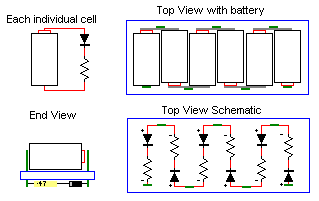
The equaliser tray is a device used to flatten each cell in a pack to an equal voltage, this is done after the pack is semi-flattened using your preferred method (if you don't already have one check out the bulb discharger and cut- off). This is done to stop cell reversal, which can have very bad effects on your packs. The pack doesn't have to be equalised every time you discharge but the more often you do it the better.
To make the discharger you will need:
6 2Amp+ Diodes
6 .47ohm 5W Resistors
1 Tray which has contacts to the of each cell (see diagram)
The diodes need to have a current rating of about 2 amps or more, this can either be done using six single 1N5404 (3A) diodes or six pairs of 1N4004 (1Amp) diodes connected in parallel. If these specific diodes aren't available from your local electronics store they should be able to point you to something suitable.

A resistor and diode simply have to be placed in series across each individual cell as shown in the diagram (take care with polarity of diode). They both dissipate energy but the diode stops the battery discharging past 0.7 volts. This means than the cell that goes flat first won't be forced into cell reversal by the rest of the pack, which can occur if they are all discharged in series as with normal dischargers.
The tray may
take a few hours to discharge all the cells if they were not close to being
flat at the start. You can check when the pack is finished by measuring
the voltage across each individual cell, they should all be in the range
of .7 to .8 volts when finished.
If you can't
make the tray part you can simply make 6 individual dischargers (as shown
in the diagram) and place a pair of clips on the end of each, these can
then be attached to each cell.